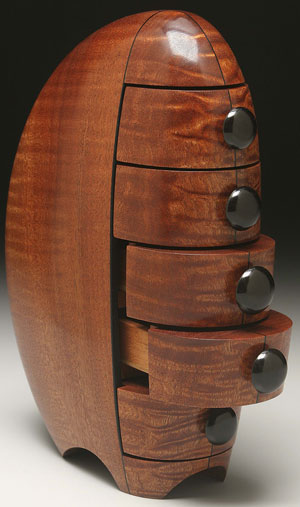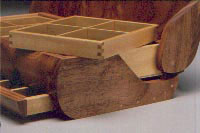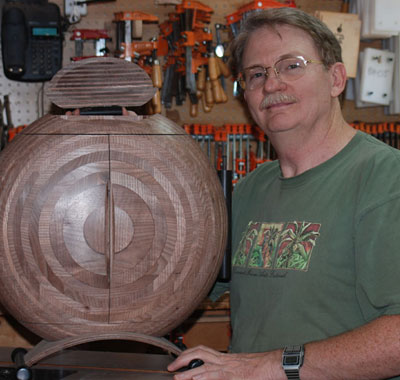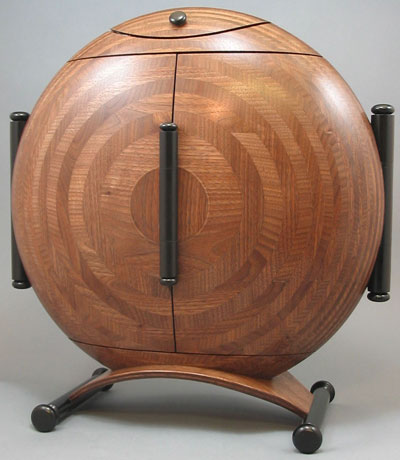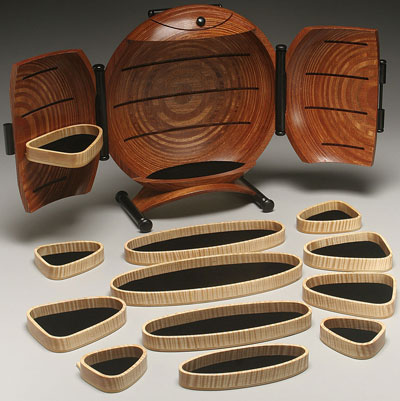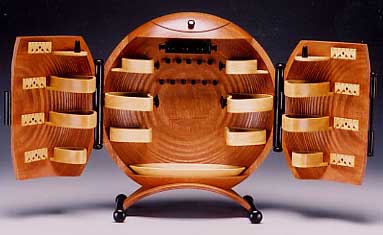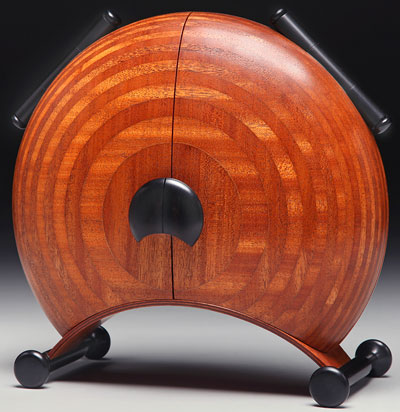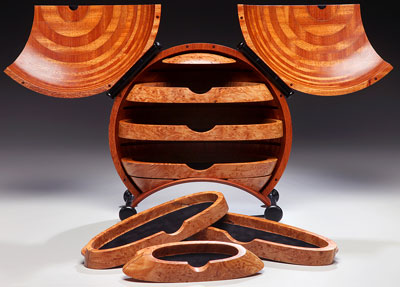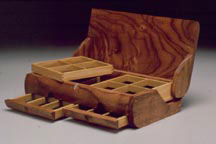
Ray Jones’s focus these days is making boxes – over 10,000 in the last 25 years, according to his estimates. And not only does he make wooden boxes, he makes the “hardware” hinges from wood, too.
Ray used to work as an aerospace engineer – but he put himself through college with a summer job in construction that “gave me a lot of confidence working with my hands.” When he finished his degree in aeronautical engineering and moved to Los Angeles, he rented a house and, “instead of buying furniture, I bought tools and made furniture.”
His first box was one he designed for his wife, before she was his wife, as a traveling jewelry case: it needed to have no sharp edges. Although the interior design of that box has changed over the years – these days, it uses standard rectangular jewelry box components for the interior – it’s a design that he still produces.
“Boxes appeal to me, partly because of the mechanics of it,” Ray said. “They have hinges, they have parts that open and close. Everybody seems to need a box. It’s a good market.”
With that in mind, after Ray left his engineering job to start a woodworking business, it wasn’t long before he put aside the other things he had been building, such as clocks, desk accessories and rolling pins, to focus on boxes. “I could concentrate on making them faster and better. It was the best marriage of interest and market.”
It’s for his own aesthetics that his wooden boxes have to be “all wood — wooden hinges,” Ray said. He creates the hinges himself, as both a design feature, particularly in his turned boxes, and a functional component. “Several years ago, I bought some ebony from someone who had bought [the inventory of] a pool cue company that had gone out of business. A lot of short turning squares of ebony” – which he’s been using to make hinges of contrasting wood to some of his box bodies.
“I like using different kinds of wood. I’m just fascinated with wood, there’s so many species, each one with its own colors and textures and figure,” Ray said. “I’m always looking for ‘new’ woods. I like using things that are less common, that you may not have seen before.”
Figured woods like quilted maple and koa, contrasting woods like ebony, walnut or madrone burl, or unusual woods like “white mahogany” avodire from Africa are among the species Ray uses. He employs some of them to make his own plywood for turned boxes, so that he can avoid the unforeseen defects that often crop up in commercial veneers when they’re turned.
Among Ray’s turned boxes are his half-moon style boxes, a shape that came about when he was designing in his mind while his body was standing at the lathe making other boxes. They’re inspired by a turned stamp holder he used to make, the size and mostly the shape of a billiard ball, although it was flat on the bottom. Ray wanted to come up with a box that “wouldn’t have a lift-off lid, and wouldn’t look like all the other turned boxes.”
He also makes turned boxes that look like sculptural pieces “but then the doors open and it’s a functional box, with a shelf in contrasting woods. There’s a certain ‘wow’ factor when you open the doors.”
To create his wooden hinges for some of these boxes, Ray turns cylinders that are then cut into three pieces, with the two outer pieces glued to the box and the center piece glued through the box door. He routs a round groove into the box so the cylinder fits into it. For his production boxes, his wooden hinges are frequently pin and socket type hinges created from dowels that are attached to either side of the box lid, and through a hole drilled in the side of the body of the box.
For those boxes where the wooden hinge is part of the design, they’re an obvious feature. For the production type boxes, although the wooden hinges are there, they’re not as obvious. At the shows where he sells most of his work these days, Ray says, “I point it out.”
